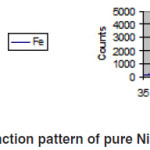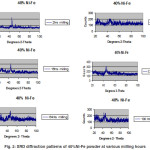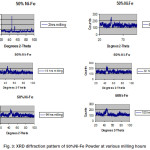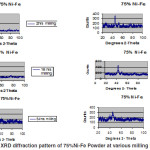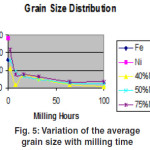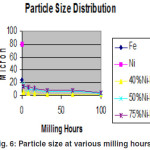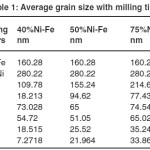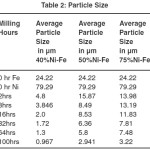A study of grain and particle sizes of 40%Ni-Fe, 50%Ni-Fe and 75%Ni-Fe nanopowder prepared by mechanical alloying
T. ASHOK KUMAR¹*, A. RAJADURAI² and GOUTHAMA³
¹Rajalakshmi Engineering College, Thandalam - 602 105 (India).
²Madras Institute of Technology, Chromepet - 600 044 (India).
³Indian Institute of Technology, Kanpur - 208 016 (India).
Article Publishing History
Article Received on :
Article Accepted on :
Article Published : 14 Apr 2017
Article Metrics
ABSTRACT:
Mechanical alloying through high energy ball milling was used to produce Ni-Fe alloy powders starting from elemental Ni and Fe powders of average particle size 80 and 25 μm respectively. High Energy Planetary ball milling at room temperature was performed for various time durations ranging between 2 to 100 hours. X-ray Diffraction (XRD) and Particle Size Analyzer were used for characterization of powders. Comparing the three alloys when the percentage of nickel increases the rate of reduction of grain and particle size decreases. During mechanical alloying while the grain size changes the particle size almost remain constant or the particle size changes the grain size almost remain constant. This may be due to the energy consumption either changes in grain size or particle size during mechanical alloying.
KEYWORDS:
Mechanical Alloying; Particle Size; Morphological Study; Microstructure; Recrystallization
Copy the following to cite this article:
|
Copy the following to cite this URL:
|
Introduction
Ni-Fe alloys of varying compositions are extensively used in electromagnets due to their low hysterics loss, high permeability and high saturation flux density. Their mechanical properties can be improved using several techniques such as recrystallization,¹ solid state sintering,2 cyclic heat treatment3,4 formation of matrix pools,5 surface carburization,6 formation of irregular particle shape,7 and mechanical alloying.8 During the last few years major advances have been made in the study of behavior of small particles due to their enhanced properties. The mechanical alloying process developed by Benjamin,9 is an advanced fabrication process which can produce very fine and homogenous powder. Mechanical milling has been suggested as a process to develop alloys with improved mechanical properties and Magnetic.11 In the present work morphological study and microstructure analysis of Ni-Fe powders produced using mechanical alloying was carried out.
Experimental
Elemental powders of Nickel and Iron with the purity of 99.8 and 99.5, particle size 80 and 25µm and grain size 280 and 160nm respectively were used as starting materials. Powder mixture of 40% Ni-Fe, 50% Ni-Fe and 75% Ni-Fe were selected as the starting materials for the study. High Energy Planetary ball milling was performed with a laboratory planetary mill (RETSCH) with ball to powder mass ratio of 10:1 at a speed of 300rpm using stainless steel jars and balls. The jars were sealed under atmospheric pressure and temperature. Toluene was used as a process control agent. Small amounts of the powder were taken out from the mill at 2, 8,16,32,64 and 100hrs to measure grain and particle size. X-Ray Diffraction (XRD) and Master Sizer particle size analyzer were used the characterization of powder particles. The average grain size was calculated from XRD images using Scherrer’s equation.10 A Mastersizer Particle Size Analyzer was used to measure the particle size.
Results and Discussion
XRD Pattern
The XRD spectra of pure Fe and Ni are shown in Figure 1 those of 40% Ni-Fe powder, 50% Ni-Fe and 75% Ni-Fe powder at various milling hours are shown in Figure 2, Figure 3 and Figure 4 respectively. Comparing Figures 1, 2, 3 and 4 it can be seen that the X-ray diffraction peaks widen as the milling time increased. This could be explained as due to the refinement of grain size and increases of micro strain during mechanical alloying. It is observed that the value of maximum counts of the diffraction peaks keep on decreasing with increasing milling hours due to the fracturing of the particles. It can be seen that at 8 hours of milling of 40% Ni-Fe alloy exhibits XRD pattern reflecting amorphous structure. This shows that the amorphization is fully achieved by ball milling alone after 8hours of milling with out performing additional heat treatments such as annealing for milled power products.
Grain Size
The average grain sizes were calculated from the super imposed XRD (111) peak of Ni and (110) peak of Fe using Scherrer’s equation.10 The variation of the grain size with milling hours is listed in Table I and graphically shown in Figure 5. It can be seen in 40%Ni-Fe alloy that the grain size first decreases with milling till 8 hours and then increases reaching the next highest value at 16 hours. After 16 hours the grain size continuously decreases reaching the lowest value of 7.3 nm at 100 hours. In case of 50% Ni-Fe alloy the grain size decreases rapidly at the beginning of the milling and after 64 hours of milling the change in grain size is not appreciable i.e. 26 to 22 nm only. In case of 75% Ni-Fe alloy the grain size decreases rapidly at the beginning of the milling and after 64 hours of milling the change in grain size is not appreciable i.e. 35nm to 34nm only.
The variation of average particle size with milling time is listed in Table II and shown in Figure 6 In 40% Ni-Fe alloy for Ni powder the particle size decreases from 80 µm to 4.8 µm after 2 hours while for Fe the decrease is only from 24 µm to 4.8 µm at 2 hours. In 50% Ni-Fe alloy for Ni powder the particle size decreases from 80 to 16 µm at 2 hours while for Fe the decrease is only from 24 to 16 µm at 2 hours. In 75% Ni-Fe alloy for Ni powder the particle size decreases from 80 to 13.98 µm at 2 hours while for Fe the decrease is only from 24 to 13.92 µm at 2 hours. The decrease is much higher for Ni due to its less ductility compared to Fe. In 40% Ni-Fe alloy the particle size decreases continuously with milling time as the fracturing forces dominate over the cold welding forces over the entire period. However between 32 hours to 100 hours, the particle size does not change appreciably due to the equilibrium between the fracturing and cold welding forces. The particle size reaches the lowest value of 0.967µm at the end of 100 hours of milling. In 50% Ni-Fe alloy between 8 to 16 hours, the particle size does not change appreciably due to the equilibrium between the cold welding and fracturing forces during this period. In 75% Ni-Fe alloy during 2 to 8 hours of milling in the particle size remains constant at 13.5 µm. During 32 to 64 hours of milling, it is observed that the particle size remains constant at 7.5 µm. This may be due to equilibrium between the fracturing and cold welding forces in these regions of milling. The particle size decreases after 64 hours and reaches the lowest value of 3 µm at 100 hours of milling. Thereafter the particle size decreases with the milling time as fracture of heavily deformed mechanically alloyed powder begins to dominate. The lowest particle size is 2.9µm and is obtained after 100 hours of milling. Comparing those three alloys, it could be observed that the percentage of nickel increases the rate of reduction of grain and particle size decreases because of Ni is little harder than Fe. It can be observed from Table I and II during mechanical alloying while the grain size changes the particle size almost remain constant or the particle size changes the grain size almost remain constant. This may be due to the energy consumption either changes in grain size or particle size.
Conclusion
Mechanical alloying of 40% Ni-Fe and 50%Ni-Fe have been investigated using X-ray Diffraction, Scanning Electron Microscope and Particle Size Analyzer. The main conclusions drawn from the study are:
From the XRD spectra for 40%Ni-Fe alloy at various milling hours, it can be seen that at 8 hours of milling the alloy exhibits XRD pattern reflecting amorphous structure. This shows that amorphization is fully achieved by ball milling alone after 8 hours of milling with out performing additional treatments such as annealing for milled power products.
The grain size in 40%Ni-Fe alloy is observed to decrease with milling till 8 hours and then increases and reaching the next highest value at 16 hours. After 16 hours the grain size continuously decreases reaching the lowest value of 7.3 nm at 100 hours. In 50%Ni-Fe alloy the grain size was found decrease rapidly at the beginning of the milling and after hours of milling the change in grain size is not appreciable i.e. 26 to 22 nm only. The grain size in 75% Ni-Fe alloy is decreases rapidly at the beginning of the milling and after hours of milling the change in grain size is not appreciable i.e. 35 nm to 34 nm only.
In 40%Ni-Fe alloy the particle size decreases continuously with milling time. Between 32 hours to 100 the change is not appreciable. The particle size reaches the lowest value of 0.967µm at the end of 100 hours of milling. In 50%Ni-Fe alloy between 8 hours to 16 hours, the particle size does not change appreciably. Thereafter particle size decreases with the milling time .The particle size is the lowest at 100 hours of milling of 9µm. In 75% Ni-Fe the particle size generally decreases with milling time. Equilibrium between fracturing and cold welding forces is found to be established between 2 and 8 hours and also between 32 and 64 hours of milling as shown by the nearly constant particle size in these regions.
When the percentage of nickel increases the rate of reduction of grain and particle size decreases. In mechanical alloying while the grain size changes the particle size almost remain constant or the particle size changes the grain size almost remain constant. This may be due to the energy consumption either changes in grain size or particle size.
Acknowledgments
The authors wish to thank the management of Rajalakshmi Engineering College for permitting the author to do the experimental analysis in IIT. Kanpur on duty. Thanks are due to IIT, Kanpur for permitting the author to use their experimental facilities such as SEM, XRD, Particle size analyzer and Ball milling without which this work could not have been possible.
References
- G.R. Goren-Muginstein and A.Rosen, The effect of cold deformation on grain refinement of heavey metals, Mater.Sci. Eng. 238: 351 (1997).
- H.J.Ryu. S.H. Hong, and W.H. Back, Microstructure and mechanical properties of mechanically alloyed and solid state sintered tungsten heavy alloys, Mater,Sci. Eng. A, 291: 91 (2000).
- J.W.Noh, E.P.Kim, H.S.Song, et al., Matrix penetration of w/w grain boundaries and its effect on mechanical properties of 93W-5.6Ni-1.4Fe heavy alloys, Metall. Trans.A, 24: 2411 (1993).
- J.W.Noh, M.H. Hong, G.H.Kim, et al., the cause of matrix penetration of W/W grain boundaries during heat treatment of W-Ni-Fe hevy alloy, Metall. Trans, A, 25: 2828 (1994).
- S.H. Hong, H.J. Ryu, and W.H. Baek,Matrix pools in partially mechanically alloyed tungsten heavy alloy for localized shear deformation, Mater. Sci. Eng. A, 333: 187 (2002).
- S.h.Jung, D.k. Kim, S.Lee, et al., Effect of surface carburization on dynamic deformation and fracture of tungsten heavy alloy, Metal. Mater. Trans. A, 30: 2027 (1999).
- H.S. Song, J.W. Noh, W.H. Baek, et al., Undulation of W/Matrix interface by resintering of cyclically heat-treated W-Ni-Fe heavy alloys, Metall. Trans.A, 28: 485 (1997).
- H.J.Ryu. S.H. hong, and W.H. Baek, Combination of mechanical alloying and two-stage sintering of a 93W5.6Ni1.4Fe tungsten heavy alloy, Mater.Sci.Eng.A, 344: 253 (2003).
- J.S.Benjamin, Dispersion strengthened super alloys by mechanical alloying, Metall. Trans.A, 1: 2943 (1970).
- Carmen A.Huber; X-Ray Diffraction Characterization of Nanophase Materials; National Science Foundation, Arlington, Virginia, ISBN 0-333-56814-1: 325 (1992).
- Ashokkumar T, Rajadurai A, Gouthama and Sampath, Material Science Research India, 5(2): 283-292 (2008).

This work is licensed under a Creative Commons Attribution 4.0 International License.
